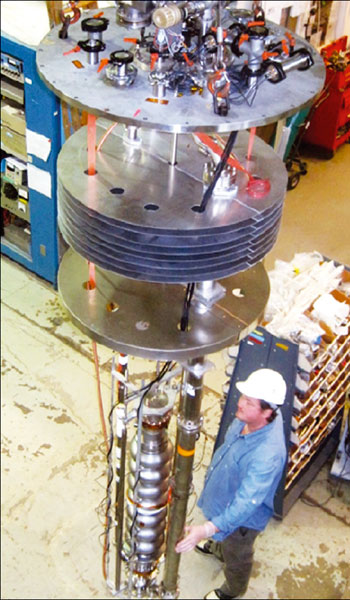
Image credit: Cornell/LEPP.
Synchrotron X-ray sources have become essential tools across the sciences, medicine and engineering. To continue the rapid pace of advances in these fields, researchers need much better high-intensity sources of short-wavelength X-rays to capture ultrafast phenomena and probe materials with atomic resolution. Existing continuous-duty synchrotrons fall short because they produce mostly incoherent light, so there is now a worldwide race to build coherent, high-flux hard X-ray sources.
Cornell University has for some time received funding to conceive, design and prototype innovative superconducting technology for an energy-recovery linac (ERL) as a basis for a next-generation source. Towards the end of 2011, the team at Cornell surpassed three important milestones on the road towards a coherent source and is now within striking distance of delivering performance that matches theoretical limits.
The goal of an ERL light source is to create ultralow-emittance electron bunches, accelerate them in a superconducting linear accelerator and then circulate them only once through a series of small-gap undulators to produce ultrabright, short pulses with a high fraction of transversely coherent, hard X-ray light. The electron’s energy is then recovered to accelerate a new, high-brightness beam. Three of the biggest R&D challenges are to prove that it is possible to build an electron injector with sufficient current and sufficiently small emittances, as well as a superconducting linac with sufficiently small energy consumption.
Cornell’s prototype injector has achieved the first milestone by delivering a continuous-duty current of 35 mA. This is the world record for any laser-driven photocathode electron gun and is above the specification for one of the proposed operating modes. The team is now ramping up the current to even higher levels.
The normalized emittance goals at Cornell are around 0.1 mm mrad for a bunch charge of about 20 pC and 0.3 mm mrad at some 80 pC, i.e. for a 100 mA beam of 1.3 GHz bunches. The emittances achieved for the bunch cores (the central 2/3 of the bunch) are <0.15 mm mrad at 20 pC and 0.3 mm mrad at 80 pC. The team expects even better values as the injector voltages are ramped up. For comparison, at 5 GeV a 0.1 mm mrad emittance yields a geometric horizontal emittance of 10 pm mrad. The current world-record storage-ring source, PETRA-III at DESY, operates with a geometric horizontal emittance of 1 nm mrad.
Finally the energy requirement for the first prototype cavity of Cornell’s X-ray ERL has been shown to be as small as proposed in a vertical cryogenic test (Q0 = 2 × 1010 at 16 MV/m), thus reaching the third milestone.
While much remains to be done, these achievements show that even this first prototype injector, when coupled with a linac and long undulators in a full-scale ERL light source, would already produce continuous-duty (1.3 GHz) pulses of hard X-ray beams of unprecedented coherence and pulse length.
• For more details, contact Georg.Hoffstaetter@cornell.edu or see http://erl.chess.cornell.edu.








